Coiling up with snake jewellery: the enduring style of the serpent motif
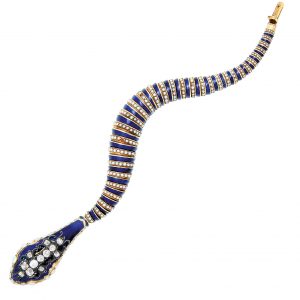

Antique Gold Caduceus Hair Ornament, by Castellani
The image of the serpent is arguably one of the most recognizable mythological symbols, steeped in history and meaning that dates back to biblical times. While snakes typically incite fear and most people would prefer to keep their distance from the creatures, when it comes to jewellery design there are few themes that draw the same iconic appeal as the snake motif.
From mythology to the runway – the history of snake symbolism
The duality of snake symbolism is most intriguing, as serpents are often seen as evil or poisonous; yet, snakes also represent transformation, fertility and healing. The ouroboros, the ancient depiction of a snake eating its own tail, symbolizes eternity and rebirth.
Ancient Mayans and Aztecs worshipped serpent gods, and the Greeks also regarded snakes as sacred. In Greek mythology, the god of medicine, Asclepius, carried a serpent-entwined staff – a symbol that is still commonly associated with the medical profession today. Ancient Egyptians viewed snakes as supernatural and regal beings, and Cleopatra herself is perhaps the first (certainly the most notable) historical figure to wear snake jewellery.
However, it wasn’t until the 1800s when the snake motif solidified itself as a renowned jewellery staple, thanks to Queen Victoria’s trendsetting engagement ring. In an era where elements of nature were often incorporated into jewellery, the snake became the perfect symbol for eternal love and commitment.
The evolution of serpent-inspired jewels
Queen Victoria’s influence and popularity catapulted the snake motif trend across England, and soon snake brooches, coiled bangles and flexible necklaces began appearing all throughout Europe.
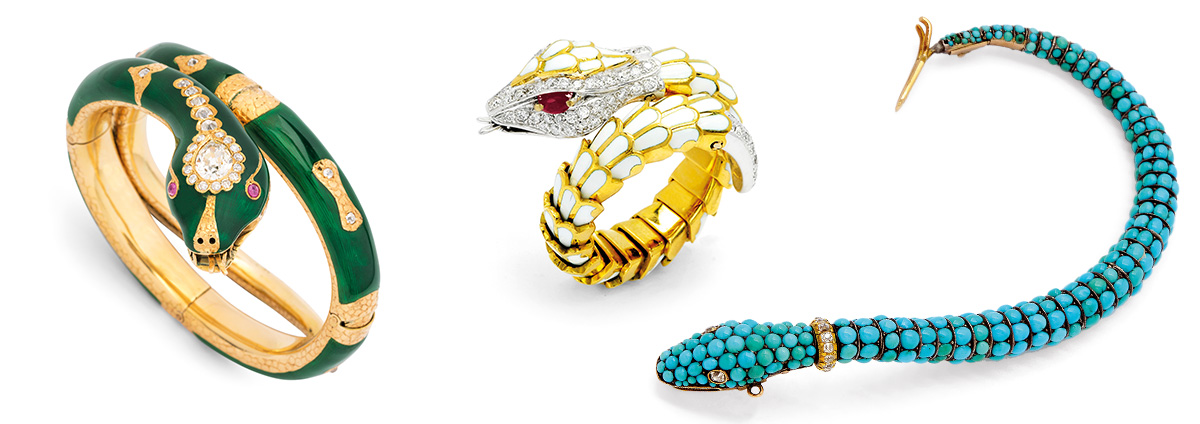
Snake motif jewels previously offered at Dupuis
This trend continued during the Art Nouveau period, with the image of the snake inspiring pieces that tied in nicely with the prominent animal motifs of the time. Through the 20th century, fine jewellery houses offered their own interpretations of the reptile:
Cartier
In the 1960s, Mexican actress Maria Félix commissioned Cartier to design a life-sized snake necklace. Taking two years to complete, the 22-inch platinum and gold serpent was fully flexible and reversible, covered in 2,473 baguette-cut diamonds, with the underside enamelled in red, green and black.
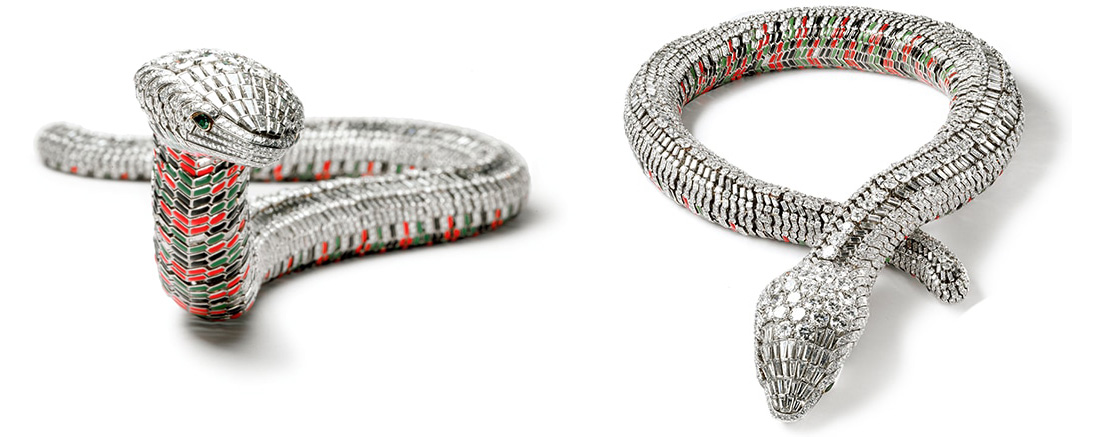
Snake Necklace by Cartier
Photo credit: Cartier.com, Cartier’s L’Odyssée de Cartier Film
Bulgari
One of the most timeless and intricate snake-themed collections is Bulgari’s Serpenti collection. Inspired by an ancient Roman practice, designers employed the Tubogas technique to create flexible, rounded bands that were comfortable and easy to wear while remaining firmly coiled – perfect to create the look of a snake wrapped around one’s wrist.
In addition to heavily featuring the unmistakable snake silhouette, the collection also showcases the head of the snake through the use of vibrantly hued gemstones. In the 1950s and 60s, Bulgari crafted several custom snake-themed pieces for fashion icons such as Elizabeth Taylor and Vogue editor Diana Vreeland.
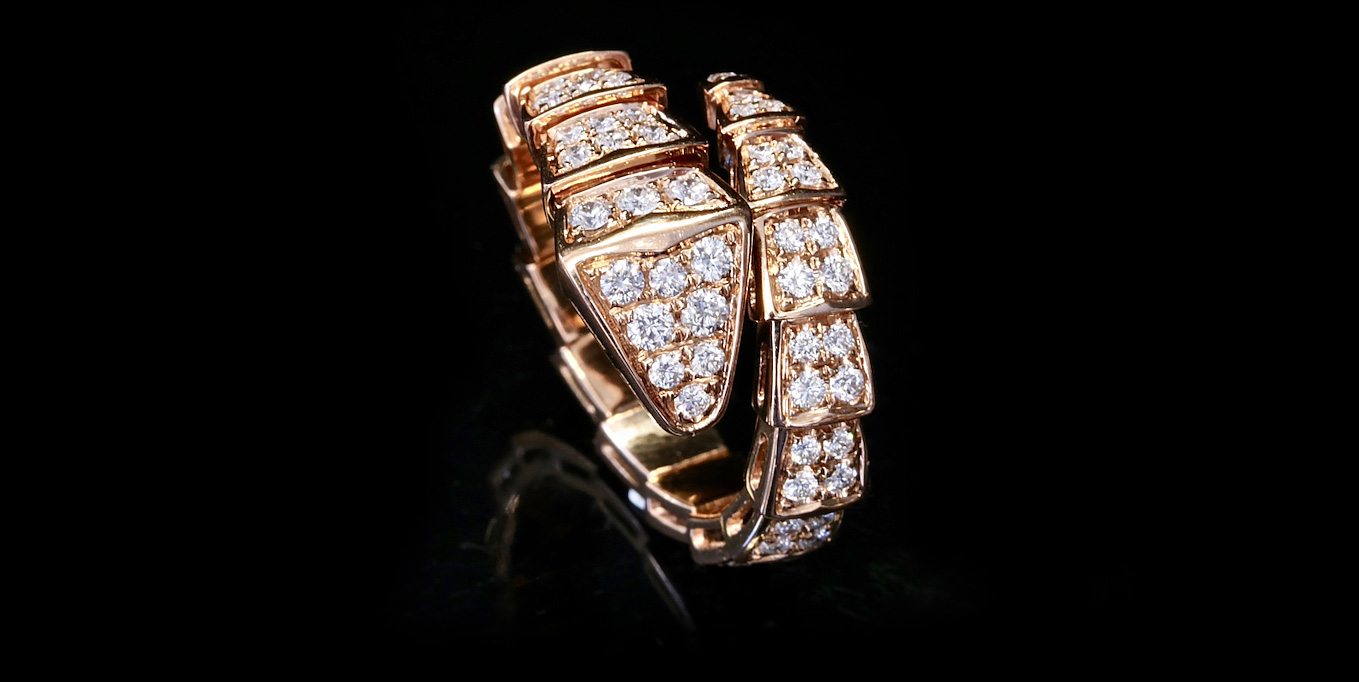
Diamond and Pink Gold ‘Serpenti’ Ring, by Bulgari
Boucheron
Boucheron has two collections dedicated to the snake motif: Serpent Bohéme and Adam. The former a more subtle nod to serpents, with engraved scales and teardrop-shaped gems that appear to be a less literal take on a snake’s head. The latter featuring more realistic renditions of the snake’s shape.

Diamond and gold ‘Adam’ bracelets, by Boucheron
Photo credit: Boucheron.com
There are countless jewellery houses across the globe that channel the exotic and mysterious allure of the serpent figure. Whether muted and delicate or bold and dramatic, the snake motif will forever be entwined in contemporary jewellery design.
Right-hand rings and what they can mean
Gone are the days when women wait for somebody else to “put a ring on it.” Ladies, single or not, are splurging on themselves and buying all types of gems, including diamonds – to wear on their right hand.

Lot 199: Diamond and White Gold Ring, Fall 2019.
As more and more women spend their own money on luxuries like jewellery, the newest version of right-hand rings is an important jewellery trend. Certainly, wearing a bright, dramatic cocktail or dinner ring has always been a way to express individual style and make a major fashion statement. The contemporary notion of a right-hand ring is a continuation of the idea of embracing one’s independence, celebrating major life moments and maybe even challenging societal norms.
What about the left hand
In the West, the left hand has traditionally been reserved for the wearing of rings that celebrate and indicate official commemorative events like an engagement, a wedding or an anniversary. We can give credit to the ancient Romans who believed that a vein of love directly connected the heart to the third finger on the left hand. A right hand jewel can be less fraught with any intentional meaning – they don’t necessarily always have to carry their own significance but can be customized to suit every individual and situation.

Diamond and Platinum Eternity Ring, by Graff. Sold for $18,000, Fall 2017.
Roots of the contemporary right-hand ring
An extremely successful DeBeers advertising campaign in the early 2000s was aimed at encouraging any woman, no matter her matrimonial status, to invest in diamond jewellery, on her own terms and at her own discretion. The ad promoted non-engagement, non-solitaire style designs, set with a multitude of small and tiny diamonds, and was summed up with this tagline: “Your left hand rocks the cradle. Your right hand rules the world.” Whether as a personal purchase or received as a gift, this inspired concept shows no signs of abating.
A right-hand ring can celebrate the birth of a child, the gem laden gift known as a “baby bauble”; an eternity band can denote a special anniversary or graduation. They can also be heirlooms, with no romantic connotation. passed down through generations. However, more commonly, they are rings that women have gifted to themselves: to mark a promotion, a milestone birthday, or even a change in matrimonial status such as a divorce. Stacked bands are a very popular look, set with either contrasting gems in white, yellow and pink gold or an allover monotone aesthetic in platinum.
Right hand jewels can still mean wedding bells
The right-hand ring is a way for women to truly express themselves, not simply advertise their marital status, however, this practice can change depending on where you are in the world.

Diamond Solitaire and White Gold Ring, Fall 2019
In Canada and the United States, engagement and wedding rings are traditionally worn on the left hand. Yet, it’s actually has been customary to wear those tokens of love on the right hand in many European countries, including Greece, Germany, Spain and Poland. German tradition has the engagement ring move from the left hand to the right after the wedding, while in Brazil and Turkey, the opposite is true. In some regions in China, woman wear their wedding band on the right hand. In the past, in a different attitudinal climate, some in the LGBTQ community, opted to wear wedding bands on the right hand to indicate a relationship.
Perhaps the best part about a right-hand ring is that there are no hard and fast rules about why or when to wear one: celebrate love for a partner (or yourself), honour an occasion, start a conversation with a statement piece. In fact, you don’t even need a reason to rock a right-hand ring, but there are certainly many great ones.
Selection of rings from upcoming auction.
Coloured gemstones or diamonds: choosing the stone that’s right for you
Diamonds may be a girl’s best friend, but what about rubies and sapphires? Coloured gemstones have long been favoured by royals and celebrities and only continue to increase in popularity. They can often be more affordable and a conversation-worthy alternative to diamond engagement rings.

How the demand for diamonds began
We know “diamonds are forever”, essentially unmatched when it comes to day-to-day durability, which is one reason why they are typically the stone of choice for engagement rings. The other reason we use diamonds to say “I do”? Clever marketing.
The historic players supplying the Western diamond market: India from the 1400s, during the 1700s major sources were found in Brazil and then huge deposits were found in 1800s South Africa. Due to their relative rarity and therefore extremely high cost, diamonds were initially only worn, in any form, by Royalty and the wealthiest of the wealthy. It wasn’t until the early 1950s when they solidified their spot at the top of the gemstone chain:De Beers Consolidated Mines, Ltd. began positioning diamond engagement rings as a symbol of love and commitment – rather than just a symbol of wealth and luxury – in a brilliant ad campaign begun in 1947 that evolved from a reaction to the extreme slump in sales after the Great Depression and post-war malaise.

Canadian Diamond Line Bracelet
Suddenly diamonds became coveted for the emotional connection they evoked, and this resulted in creating a demand unaffected by status or the economy that has held strong for decades.
The charm of coloured gems

Ruby and Diamond Ring by Van Cleef & Arpels.
There is an ever-growing interest in alternative gems. Some buyers are simply enticed by the bold statement-making appeal of a colourful gem or are perhaps drawn to the traditional meaning behind a particular stone. Certain coloured gemstones can even be more valuable and rarer than diamonds.
The big three that often come to mind when we think of precious coloured gemstones are rubies, sapphires and emeralds.
Ruby
One of the most valuable and popular gemstones, the ruby is considered the “King of Gems” and its beauty was touted in both the Bible and ancient Sanskrit texts. With its intense red hue (caused by the trace element chromium) the ruby is associated with passion, desire, power and nobility. Composed of the mineral corundum, it also has one of the highest ranking scores on the Mohs scale measuring hardness, toughness and stability, making it nearly as durable as a diamond. As practical as it is precious!

Important Sapphire and Diamond Ring, by Carvin French
Sapphire
Also composed of corundum, sapphires are suitable for everyday wear and come in virtually every colour of the rainbow, except red, when the term ruby comes into play. They are, however, commonly best known for their striking vivid blues. Steeped in fables and lore, the sapphire was a holy stone to the ancient Persians who believed the earth rested atop a sapphire formed by the heavens. The stone stands for virtue, loyalty and wisdom – ideal traits for an engagement ring!
Emerald
Dating back to the days of Cleopatra, emeralds were thought to bring good fortune and youthfulness to the wearer, a symbol of rebirth with their vibrant green hue. The emerald is the most famous member of the beryl family, and although it’s considered generally not recommended for everyday wear due to the fact that it’s not as hard as many other gems, it’s certainly a very special choice for special occasions.

Emerald and Diamond Bracelet
Don’t forget about fancy colour diamonds
Diamonds are graded on the internationally respected GIA’s scale from D to Z, from colourless to a subtle, but still noticeable, very, very pale yellow. Separate from that scale, diamonds of colour are considered “fancy” and comprise naturally occurring shades of blue, red, yellow, green, orangey, pink, brown, champagne, etc.
Unlike diamonds falling on the D-to-Z chart that become less valuable the more apparent their colour, fancy coloured diamonds actually increase in value based on the depth of hue. Colour saturation is described within a range from faint to light, to intense, to deep and ultimately, to the highly desirable, vivid.

Pair of Important Coloured Diamond Rings
Your choice, your desire
Whether you choose to opt for a more daring coloured gemstone for your engagement ring, or stick with a classic and traditional diamond, there are plenty of options to suit your budget, taste and style – the colourful or subtle choices that will flatter you are absolutely endless!
The lasting appeal of transformable jewellery
For many wearers, fine jewellery is intensely personal, a form of self-expression and individual style. Convertible jewellery pieces are a clever way to maximize this element and truly customize your collection.
Whether reconfiguring a piece completely, such as turning a tiara into a necklace, or simply connecting a pair of bracelets end-to-end, transformable jewellery allows you to create a number of different styles: take your look from day to night, from office to out on the town, from chic to glam.

An Art Deco Diamond and Platinum Necklace, circa 1930
Perhaps the most appealing part of convertible jewellery is the practical aspect. Not only do you get to enjoy wearing the same piece multiple ways, this idea speaks to the minimalism trend – Marie Kondo would have to agree a beautiful piece of fine jewellery that eliminates the need for several other pieces would definitely spark joy. Transformable pieces are also ideal for travelling, since you will only need to pack one or two pieces but will still able to enjoy several different looks.
You also get greater cost per wear value from your jewellery collection – without having to sacrifice and settle for lower quality. You still get fine craftsmanship without breaking the budget. The luxury version of two for the price of one!

Diamond ring with jacket of organic freeform design.
What exactly is convertible jewellery?
Convertible jewellery is essentially an item that can shape-shift via an easy and somewhat temporary modification without the need to dash over to your local jewellery professional: it’s something you can do on your own, in the privacy of your own home, no special skillset or professional tools required, thus giving the illusion there’s more than one piece in play, rather than just a single jewellery item.

A Pair of Emerald and Diamond Ear Pendants, by Buccellati.
Transformable designs can be achieved in myriad ways: attaching or removing an elaborate drop pendant from a simpler surmount creates the style known as a Day/Night earring; four matching bracelets attach to form a long necklace, and vice versa, that same long necklace divides to be worn as a shorter version with a single bracelet. One of the most common examples would be a double-clip brooch that separates into a pair of brooches. For a special event, your simple diamond solitaire ring can take centre stage amidst a removable bejewelled “jacket” that slips over the main stone. Classic diamond studs can also benefit from the same type of embellishment. The possibilities are limitless and a true testament to a designer’s skill.
From necessity to luxury
Convertible jewellery first began trending after the stock market crash in 1929 and the early years of the Great Depression. Clever and creative jewellery houses acknowledged the tough times, but also saw an opportunity that allowed them to market to women with tighter purse strings: versatile, economical and very appealing.
Something born out of practicality soon became something coveted in its own right, inspiring remarkable feats of design that have earned prominent houses a place in history with their technical intricacy. The innovations of luxury brands such as Van Cleef & Arpels, Cartier and Chaumet have made a mark that’s left a lasting impression on the world of jewellery design.
Iconic transformable jewellery
Convertible jewellery pieces are still very much haute couture, as revivals of this trend gain notice on Paris runways, with debuts from De Beers, Anna Hu and Piaget in recent years.
Then there are the absolutely iconic transformable pieces, either original to, or inspired by the Art Deco era, having earned their place in fine jewellery history.

ZIP necklace by Van Cleef & Arpels. Photo credit: Van Cleef & Arpels, vancleefarpels.com
Arguably the most notable piece of transformable jewellery is the famous Zip necklace by Van Cleef & Arpels, an idea inspired by the Duchess of Windsor in the 1930s, and the first zipper crafted from precious metal. The design can be worn as a bracelet or a necklace and took years to perfect.
Transformable jewels from the upcoming auction.
Puttin’ On the Ritz with Art Deco jewellery
If you think of the high-spirited, high society Roaring Twenties, then fun, fashion and frolic might come to mind. It was the birth of the Art Deco era with its heightened predisposition to notorious and extravagant glamour. Daring designs emerged, most especially in jeweller that continues to be popular today.
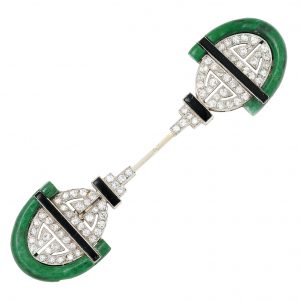
Lot 74 An Art Deco Jadeite, Onyx, Diamond and Platinum Jabot Pin, by Lacloche Frères
Defining Art Deco
The Art Deco era occurred in the midst of a prosperous Post-war economy, Thriving industries, including those dealing in precious jewellery, were actively and enthusiastically supported by the gentry. Times and morés were changing and such strictures, particularly for women, were beginning to relax, leading to a new sense of freedom and the power to express their individuality through their accessories. Those so inclined were able to lavish money, or more likely their husband’s money, on luxuries like fine jewels. Advancements in materials and methods allowed designers to take new risks in design.
The period is mainly considered to span from the 1920s to the 1930s, and was popularized at the hugely important exhibit of designers and manufacturers invited to show the world their latest and greatest innovations in Paris in 1925. The scope of the new look was vast and influenced not just jewellery but everything from fine art, to household items and architecture: picture the silhouettes of New York’s landmark Chrysler and Empire State buildings. Subsequently, the term Art Deco was coined only in the 1960s to categorize the overall style and the name is credited to Art historian Bevis Hillier who derived it from that highly significant 1925 gathering, the Exposition Internationale des Arts Decoratifs et Industriels Moderne.
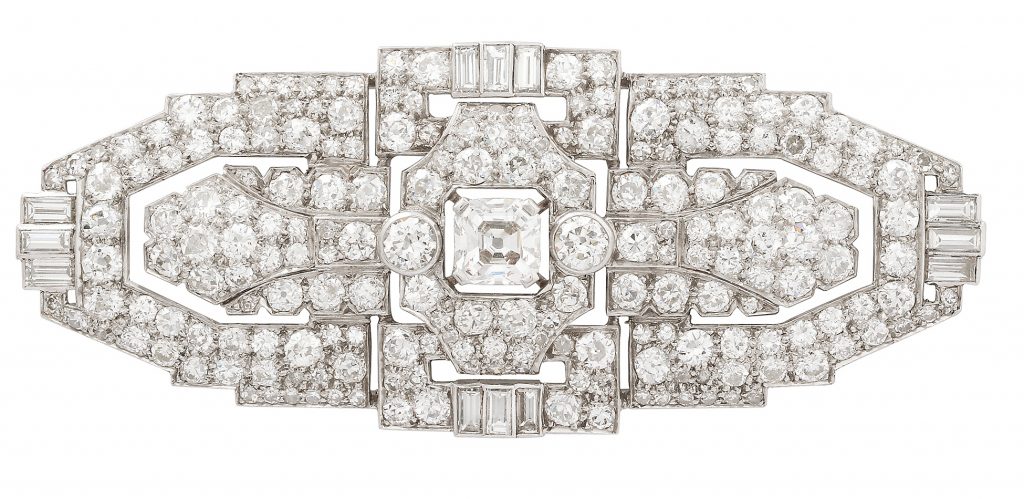
Lot 296 An Art Deco Diamond and Platinum Brooch, circa 1930.
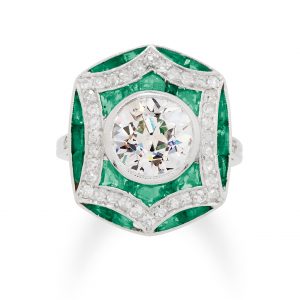
Lot 290 An Art Deco Diamond, Emerald and Platinum Ring, circa 1920
How to spot Art Deco
Geometric patterns
Signature design elements include precisely defined angles, regimented linear qualities and a more industrial feel via pleasingly repetitive and symmetrical patterns. Bold shapes and strong grid-like lines and tiered stepped edges are the calling cards of Art Deco. Look for rectangles, triangles, circles and squares. Mitre-shaped terminals are also indicative of popular motifs, whether singly or as part of convertible double-clip brooches.
Old-cut diamonds
Look for round old European-cuts which overlap in time and evolve into the scintillating transitional-cut. The elegant squared, Asscher-cuts are obviously evocative of the era and are still surprisingly modern looking. Commonly, smaller accent diamonds are baguette, bullet-cut and shield-shaped.
Platinum and white gold
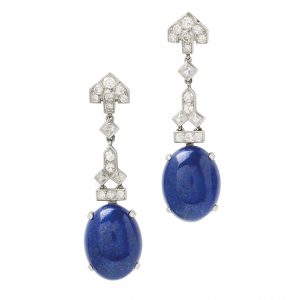
Lot 222 An Art Deco Pair of Lapis Lazuli, Diamond and Platinum Ear Pendants, by Cartier
White metals were in vogue during the Art Deco era, especially platinum, while white gold was considered a popular substitute and a more affordable alternative with a similar look.
Colour in gemstones
Art Deco pieces often get their bright colours from rubies, emeralds and sapphires, sometimes seen in Tutti-Frutti carved leaves or what’s known as calibré-cut, rows of very small multiple gems that are customized to fit narrow specialty channels and uniformly spaced tightly together rather than individually amid visible claw settings. Jade, black onyx, coral, rock crystal and lapis lazuli effectively create harmonious combinations of striking contrast when paired with diamonds.
Drawn to Art Deco?
Art Deco retains its influence with a unique ability to channel vintage elegance while still evoking a contemporary feel. This universal modern appeal widens its desirability among fashion enthusiasts. If you’re craving a genuine statement piece to reflect your personal style, consider the timeless allure of Art Deco jewellery.
Dupuis Fine Jewellery Auctioneers offers several unique and hard-to-find pieces sure to speak to your inner flapper:
Brooches for the modern millennial
Gone are the days when glamourous brooches were reserved exclusively for grandmothers and ladies who lunch. This season, the bolder the better when it comes to your jewellery, with playful embellished pieces making their way down runways and the red carpet.
Why not make your own daring fashion statement with a sophisticated brooch? Perhaps paired with a great-fitting suit à la Beyoncé, or worn as a cute but practical way to keep your shawl in place. The options are limitless for these versatile accessories.
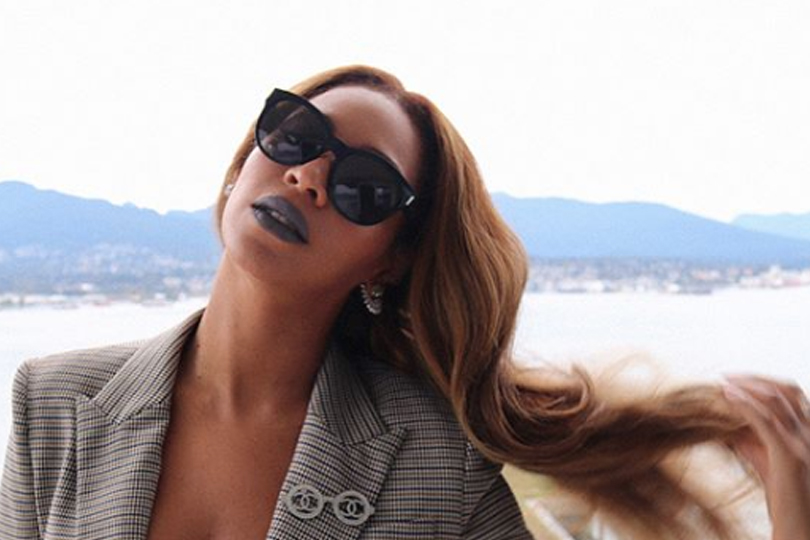
Photo source: https://www.instagram.com/beyonce/?hl=it
How to wear a brooch

Lot 12 June 2019
Bedazzle your blazer
Transport your basic black blazer from the office to an evening out by simply adding a colourful brooch to the lapel. It also works as a fancy topper for a button-up blouse.
A Gem-Set and Gold Clip Brooch, Mauboussin, circa 1974
With overlapping curved rows of diamond, ruby, emerald and sapphire-set leaves, mounted in 18k gold, signed Mauboussin and numbered 33248, French assay marks
Estimate: $1,800-2,200

Lot 138 June 2019
Pretty up your pant suit
Add some feminine flair to your favourite power pant suit with a delicate brooch and embrace the best of both worlds.
A Mother-of-Pearl, Black Jade and Gold Brooch, Tiffany & Co.
The crescent form depicting the profile of the man-in-the-moon, composed of a mother-of-pearl panel and a black nephrite jade eye, mounted in 18k gold, signed Tiffany & Co.
Estimate: $1,400-1,800

Lot 205 June 2019
Something old, something bold
Looking for the perfect addition to your wedding day wardrobe? You can never go wrong with a timeless vintage brooch.
A Diamond and Platinum Brooch/Pendant, Primavesi & Kaufmann
The large floral and ribbon spray decorated with a round diamond and a pair of pear-shaped diamonds together weighing approximately 1.55 carats, further accented by round, marquise and baguette-cut diamonds weighing approximately 5.75 carats, mounted in platinum
Estimate: $3,000-4,000

Lot 296 June 2019
Old is new again
Vintage brooches work with more than just wedding gowns: pair with more modern bold prints or colours to refine a contemporary style.
An Art Deco Diamond and Platinum Brooch, circa 1930
The large pierced geometric plaque centering an Asscher-cut diamond weighing approximately 1.25 carats, decorated throughout with round, old European and baguette-cut diamonds weighing approximately 10.80 carats, mounted in platinum
Estimate: $6,000-9,000

Lot 353 June 2019
Pin it just right
A basic rule of thumb is to keep your brooch positioned over the bust on either side (sometimes both!), or even at the centre of the neckline for a perfectly streamlined look.
A Diamond, Ruby, Platinum and Gold Clip Brooch, Cartier
Centering a round diamond weighing approximately 1.05 carats, surrounded by radiating baguette-cut diamonds, amid trios of pear-shaped ruby florets weighing approximately 5.00 carats, alternating with pavé-set diamond leaves, mounted in platinum and 18k yellow gold, signed Cartier, Paris and numbered 013422, French assay marks
Estimate: $12,000-15,000

Lot 221 June 2019
Bling out your bag
Fastening your favourite brooch to a clutch or bag is a great way to add some pizzazz to even the plainest purse.
An Antique Diamond, Silver and Gold Brooch/Pendant, circa 1875
The starburst design centering an old mine-cut diamond weighing approximately 0.80 carat, surrounded by twenty undulating rays set with old mine and rose-cut diamonds weighing approximately 6.50 carats, mounted in silver and 14k gold, with fitted box
Estimate: $6,000-8,000

Lot 234 June 2019
Secure your scarf
When travelling, create a totally new look by draping a lightweight colourful square of silk or a ubiquitous Pashmina shawl, making it so much easier to comply with mandatory weight restrictions.
A Diamond, Platinum and Gold Clip Brooch, Schlumberger, Tiffany & Co.
The highly bombé curved form with graduated tiered rows of curled leaves, decorated by round diamonds and ropetwist details, mounted in platinum and 18k gold, signed Tiffany & Co., Schlumberger
Estimate: $8,000-10,000

Lot 167 June 2019
Cuffs qualify
Extend your jewellery reach with two or three petite forms highlighting the sleeve of a jacket or cashmere cardie, a short sleeved dress or Tee-shirt. Don’t forget the pockets, also prime territory for something pretty.
A Diamond and Platinum Bow Brooch
The asymmetrical ribbon bow and sashes fashioned with scrolls, loops and lines decorated by pavé-set and baguette-cut diamonds, mounted in platinum
Estimate: $4,000-5,000

Lot 219 June 2019
Adorn your hair
Add a certain je ne sais quoi to your bobby pins to elevate an up-do or a casual ponytail.
An Egyptian Revival Turquoise, Diamond, Platinum and Gold Bar Brooch, Cartier, circa 1925
Centering an oval bezel-set turquoise carved as a scarab, flanked by elongated wings of pierced motif and decorated by rose-cut diamonds, mounted in platinum and 14k gold, signed Cartier
Estimate: $6,500-8,500

Lot 312 June 2019
Choose a theme
Already own a floral pin? Create a charming cluster with a petite bee, a butterfly and a leaf. And a bouquet style can always be naturally grown with complementary flower motifs.
A Gem-Set and White Gold Butterfly Brooch
The butterfly decorated with round and baguette-cut diamonds, emeralds and sapphires and a navette-shaped ruby, featuring en tremblant antennae and a wing, mounted in 14k white gold
Estimate: $2,400-3,400

Lot 265 June 2019
Monochrome or contrast
Mix it up or keep it strictly one tone of precious metal or gemstone, depending on the mood and the occasion.
A Pair of Diamond, Onyx and Platinum Brooches
Of spotted animal-print inspiration, the pair of bombé penannular brooches pavé-set with round diamonds weighing approximately 8.00 carats, sprinkled with onyx, mounted in platinum
Estimate: $6,000-8,000

Lot 361 June 2019
Whimsy works
Jewellery designers, just like the internet, love cute baby animals: puppies, kittens, teddy bears and lion cubs. And hummingbirds, swans and ducklings, too.
An Enamel, Diamond, Ruby and Gold Clip Brooch, Frascarolo
Whimsically designed as a large duck with a prominent beak and webbed feet, decorated with black, yellow and orange enamel, with a ruby and diamond eye, mounted in textured 18k gold
Estimate: $2,600-2,800
Finding the right brooch
Add some glitter to your spring wardrobe with these standout pieces available through Dupuis Fine Jewellery Auctioneers.

